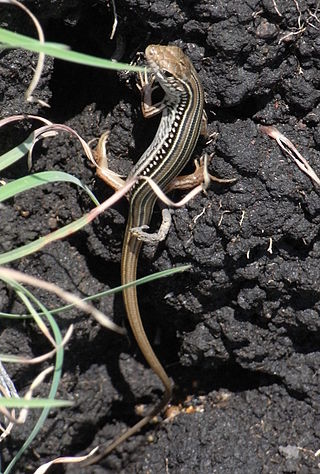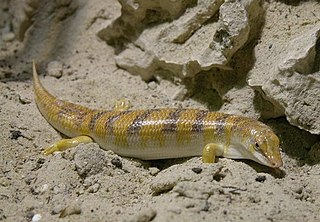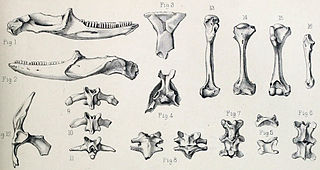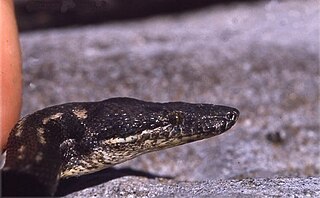
Amphiglossus is a genus of skinks, lizards in the family Scincidae.

Anomalopus is a genus of worm-skinks, smallish smooth-scaled burrowing lizards in the family Scincidae. The genus is endemic to the eastern half of Australia. The genus belongs to a clade in the Sphenomorphus group which contains such genera as Ctenotus and the close relatives Eulamprus and Gnypetoscincus.

Ateuchosaurus is a genus of skinks, lizards in the family Scincidae. The genus contains only two species which are indigenous to East Asia and Southeast Asia.

Ctenotus is a genus of skinks, lizards in the family Scincidae. The genus is endemic to Australia. The genus Ctenotus belongs to a clade in the Sphenomorphus group which contains such genera as Anomalopus and the close relatives Eulamprus and Gnypetoscincus.
Janetaescincus is a genus of burrowing skinks endemic to the Seychelles.

Lipinia is a genus of skinks, lizards in the family Scincidae. Species in the genus Lipinia are commonly called lipinias.

Scincus is a genus of skinks, lizards in the family Scincidae. The genus contains four or five species, all of which are typical desert inhabitants, living in sandy and dune-like areas with a hot and dry climate. Species in the genus Scincus can be found from Arabia to the Sahara desert.

Blue-tongued skinks comprise the Australasian genus Tiliqua, which contains some of the largest members of the skink family (Scincidae). They are commonly called blue-tongued lizards or simply blue-tongues or blueys in Australia or panana in Indonesia. As suggested by these common names, a prominent characteristic of the genus is a large blue tongue that can be bared as bluff-warning to potential enemies. The type of predator/threat that is near will determine the intensity of colour present in the tongue. The tongue can also deform itself and produce a thick mucus in order to catch prey. They are relatively shy in comparison with other lizards, and also significantly slower due to their shorter legs.

Round Island is an uninhabited islet 22.5 kilometres north of Mauritius. It has an area of 1.69 square kilometres and a maximum elevation of 280 metres. The island has been a nature reserve since 1957 and is administered jointly by the National Parks and Conservation Service and the Mauritian Wildlife Foundation. The island has been designated an Important Bird Area (IBA) by BirdLife International.

Bojer's skink is a small species of skink, a lizard in the family Scincidae. The species is endemic to Mauritius including some of its offshore islands.

The Round Island burrowing boa is an extinct species of snake, in the monotypic genus Bolyeria, in the family Bolyeriidae. The species, which was endemic to Mauritius, was last seen on Round Island in 1975. There are no recognized subspecies.

McGregor's skink is a species of lizard in the family Scincidae. The species is endemic to New Zealand.

The Mauritian giant skink is a large, extinct species of skink It was found only in Mauritius. It became extinct around 1600, probably due to human-introduced predators.

Gardiner's burrowing skink is a species of lizard in the family Scincidae. P. gardineri is the only species in the (monotypic) skink genus Pamelaescincus. The species is endemic to the Seychelles.

The Round Island boa, also known commonly as the Round Island keel-scaled boa and the Round Island ground boa, is a species of nonvenomous snake in the monotypic genus Casarea in the family Bolyeriidae. The species is endemic to Round Island, Mauritius. No subspecies are currently recognized.

The terror skink, also called commonly Bocourt's terrific skink, Bocourt's eyelid skink and Bocourt's skink, is a species of lizard in the family Scincidae. The species is endemic to the Île des Pins, a small islet off the coast of New Caledonia. First described in 1876, the species was presumed to be extinct, but was rediscovered in 1993, and since then several individuals have been seen. Because of its small area of occupation and small population size, the International Union for Conservation of Nature has assessed its conservation status as being "critically endangered".

White's skink, also known commonly as White's rock skink, is a species of lizard in the family Scincidae. The species is endemic to Australia.

Pseudemoia entrecasteauxii, also known commonly as Entrecasteaux's skink, the southern grass skink, the tussock cool-skink, and the tussock skink, is a species of lizard in the family Scincidae. The species is endemic to Australia.

Lipinia pulchella, known commonly as the yellow-striped slender tree skink or beautiful lipinia, is a species of skink, a lizard in the family Scincidae. The species is endemic to the Philippines.



















